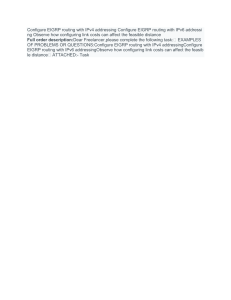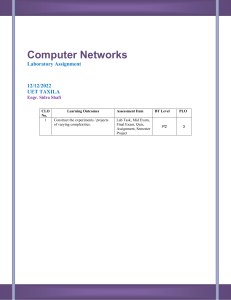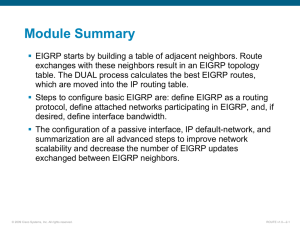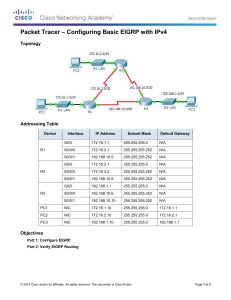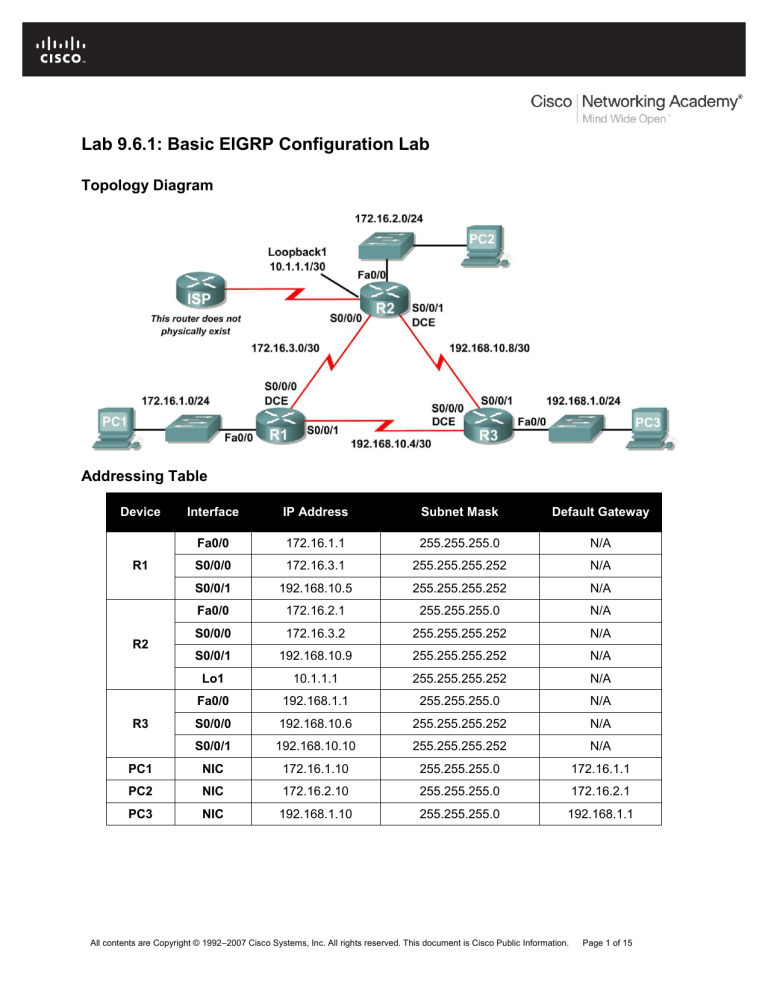
Lab 9.6.1: Basic EIGRP Configuration Lab Topology Diagram Addressing Table Device Interface IP Address Subnet Mask Default Gateway Fa0/0 172.16.1.1 255.255.255.0 N/A S0/0/0 172.16.3.1 255.255.255.252 N/A S0/0/1 192.168.10.5 255.255.255.252 N/A Fa0/0 172.16.2.1 255.255.255.0 N/A S0/0/0 172.16.3.2 255.255.255.252 N/A S0/0/1 192.168.10.9 255.255.255.252 N/A Lo1 10.1.1.1 255.255.255.252 N/A Fa0/0 192.168.1.1 255.255.255.0 N/A S0/0/0 192.168.10.6 255.255.255.252 N/A S0/0/1 192.168.10.10 255.255.255.252 N/A PC1 NIC 172.16.1.10 255.255.255.0 172.16.1.1 PC2 NIC 172.16.2.10 255.255.255.0 172.16.2.1 PC3 NIC 192.168.1.10 255.255.255.0 192.168.1.1 R1 R2 R3 All contents are Copyright © 1992–2007 Cisco Systems, Inc. All rights reserved. This document is Cisco Public Information. Page 1 of 15 CCNA Exploration Routing Protocols and Concepts: EIGRP Lab 9.6.1: Basic EIGRP Configuration Lab Learning Objectives Upon completion of this lab, you will be able to: Cable a network according to the Topology Diagram. Erase the startup configuration and reload a router to the default state. Perform basic configuration tasks on a router. Configure and activate interfaces. Configure EIGRP routing on all routers. Verify EIGRP routing using show commands. Disable automatic summarization. Configure manual summarization. Configure a static default route. Propagate default route to EIGRP neighbors. Document the EIGRP configuration. Scenario In this lab activity, you will learn how to configure the routing protocol EIGRP using the network shown in the Topology Diagram. A loopback address will be used on the R2 router to simulate a connection to an ISP, where all traffic that is not destined for the local network will be sent. Some segments of the network have been subnetted using VLSM. EIGRP is a classless routing protocol that can be used to provide subnet mask information in the routing updates. This will allow VLSM subnet information to be propagated throughout the network. Task 1: Prepare the Network. Step 1: Cable a network that is similar to the one in the Topology Diagram. You can use any current router in your lab as long as it has the required interfaces shown in the topology. Step 2: Clear any existing configurations on the routers. Task 2: Perform Basic Router Configurations, Perform basic configuration of the R1, R2, and R3 routers according to the following guidelines: 1. Configure the router hostname. 2. Disable DNS lookup. 3. Configure an EXEC mode password. 4. Configure a message-of-the-day banner. 5. Configure a password for console connections. 6. Configure a password for VTY connections. Task 3: Configure and Activate Serial and Ethernet Addresses. Step 1: Configure the interfaces on the R1, R2, and R3 routers. Configure the interfaces on the R1, R2, and R3 routers with the IP addresses from the table under the Topology Diagram. All contents are Copyright © 1992–2007 Cisco Systems, Inc. All rights reserved. This document is Cisco Public Information. Page 2 of 15 CCNA Exploration Routing Protocols and Concepts: EIGRP Lab 9.6.1: Basic EIGRP Configuration Lab Step 2: Verify IP addressing and interfaces. Use the show ip interface brief command to verify that the IP addressing is correct and that the interfaces are active. When you have finished, be sure to save the running configuration to the NVRAM of the router. Step 3: Configure Ethernet interfaces of PC1, PC2, and PC3. Configure the Ethernet interfaces of PC1, PC2, and PC3 with the IP addresses and default gateways from the table under the Topology Diagram. Task 4: Configure EIGRP on the R1 Router. Step 1: Enable EIGRP. Use the router eigrp command in global configuration mode to enable EIGRP on the R1 router. Enter a process ID of 1 for the autonomous-system parameter. R1(config)#router eigrp 1 R1(config-router)# Step 2: Configure classful network 172.16.0.0. Once you are in the Router EIGRP configuration sub-mode, configure the classful network 172.16.0.0 to be included in the EIGRP updates that are sent out of R1. R1(config-router)#network 172.16.0.0 R1(config-router)# The router will begin to send EIGRP update messages out each interface belonging to the 172.16.0.0 network. EIGRP updates will be sent out of the FastEthernet0/0 and Serial0/0/0 interfaces because they are both on subnets of the 172.16.0.0 network. Step 3: Configure the router to advertise the 192.168.10.4/30 network attached to the Serial0/0/1 interface. Use the wildcard-mask option with the network command to advertise only the subnet and not the entire 192.168.10.0 classful network. Note: Think of a wildcard mask as the inverse of a subnet mask. The inverse of the subnet mask 255.255.255.252 is 0.0.0.3. To calculate the inverse of the subnet mask, subtract the subnet mask from 255.255.255.255: 255.255.255.255 – 255.255.255.252 ------------------0. 0. 0. 3 Subtract the subnet mask Wildcard mask R1(config-router)# network 192.168.10.4 0.0.0.3 R1(config-router)# When you are finished with the EIGRP configuration for R1, return to privileged EXEC mode and save the current configuration to NVRAM. R1(config-router)#end %SYS-5-CONFIG_I: Configured from console by console R1# All contents are Copyright © 1992–2007 Cisco Systems, Inc. All rights reserved. This document is Cisco Public Information. Page 3 of 15 CCNA Exploration Routing Protocols and Concepts: EIGRP Lab 9.6.1: Basic EIGRP Configuration Lab Task 5: Configure EIGRP on the R2 and R3 Routers. Step 1: Enable EIGRP routing on the R2 router using the router eigrp command. Use a process ID of 1. R2(config)#router eigrp 1 R2(config-router)# Step 2: Use the classful address 172.16.0.0 to include the network for the FastEthernet0/0 interface. R2(config-router)#network 172.16.0.0 R2(config-router)# %DUAL-5-NBRCHANGE: IP-EIGRP 1: Neighbor 172.16.3.1 (Serial0/0/0) is up: new adjacency Notice that DUAL sends a notification message to the console stating that a neighbor relationship with another EIGRP router has been established. What is the IP address of the EIGRP neighbor router? ________________________________________ What interface on the R2 router is the neighbor adjacent to? ________________________________________ Step 3: Configure the R2 router to advertise the 192.168.10.8/30 network attached to the Serial0/0/1 interface. 1. Use the wildcard-mask option with the network command to advertise only the subnet and not the entire 192.168.10.0 classful network. 2. When you are finished, return to privileged EXEC mode. R2(config-router)#network 192.168.10.8 0.0.0.3 R2(config-router)#end %SYS-5-CONFIG_I: Configured from console by console R2# Step 4: Configure EIGRP on the R3 router using the router eigrp and network commands. 1. Use a process ID of 1. 2. Use the classful network address for the network attached to the FastEthernet0/0 interface. 3. Include the wildcard masks for the subnets attached to the Serial0/0/0 and Serial 0/0/1 interfaces. 4. When you are finished, return to privileged EXEC mode. R3(config)#router eigrp 1 R3(config-router)#network 192.168.1.0 R3(config-router)#network 192.168.10.4 0.0.0.3 R3(config-router)# %DUAL-5-NBRCHANGE: IP-EIGRP 1: Neighbor 192.168.10.5 (Serial0/0/0) is up: new adjacency R3(config-router)#network 192.168.10.8 0.0.0.3 R3(config-router)# %DUAL-5-NBRCHANGE: IP-EIGRP 1: Neighbor 192.168.10.9 (Serial0/0/1) is up: new adjacency R3(config-router)#end %SYS-5-CONFIG_I: Configured from console by console All contents are Copyright © 1992–2007 Cisco Systems, Inc. All rights reserved. This document is Cisco Public Information. Page 4 of 15 CCNA Exploration Routing Protocols and Concepts: EIGRP Lab 9.6.1: Basic EIGRP Configuration Lab R3# Notice that when the networks for the serial links from R3 to R1 and R3 to R2 are added to the EIGRP configuration, DUAL sends a notification message to the console stating that a neighbor relationship with another EIGRP router has been established. Task 6: Verify EIGRP Operation. Step 1: View neighbors. On the R1 router, use the show ip eigrp neighbors command to view the neighbor table and verify that EIGRP has established an adjacency with the R2 and R3 routers. You should be able to see the IP address of each adjacent router and the interface that R1 uses to reach that EIGRP neighbor. R1#show ip eigrp neighbors IP-EIGRP neighbors for process 1 H Address Interface 0 172.16.3.2 1 192.168.10.6 R1# Ser0/0/0 Ser0/0/1 Hold Uptime (sec) 10 00:36:51 11 00:26:51 SRTT (ms) 40 40 RTO 500 500 Q Cnt 0 0 Seq Num 13 4 Step 2: View routing protocol information. On the R1 router, use the show ip protocols command to view information about the routing protocol operation. Notice that the information that was configured in Task 5, such as protocol, process ID, and networks, is shown in the output. The IP addresses of the adjacent neighbors are also shown. R1#show ip protocols Routing Protocol is "eigrp 1 " Outgoing update filter list for all interfaces is not set Incoming update filter list for all interfaces is not set Default networks flagged in outgoing updates Default networks accepted from incoming updates EIGRP metric weight K1=1, K2=0, K3=1, K4=0, K5=0 EIGRP maximum hopcount 100 EIGRP maximum metric variance 1 Redistributing: eigrp 1 Automatic network summarization is in effect Automatic address summarization: Maximum path: 4 Routing for Networks: 172.16.0.0 192.168.10.4/30 Routing Information Sources: Gateway Distance Last Update 172.16.3.2 90 4811399 192.168.10.6 90 5411677 Distance: internal 90 external 170 Notice that the output specifies the process ID used by EIGRP. Remember, the process ID must be the same on all routers for EIGRP to establish neighbor adjacencies and share routing information. All contents are Copyright © 1992–2007 Cisco Systems, Inc. All rights reserved. This document is Cisco Public Information. Page 5 of 15 CCNA Exploration Routing Protocols and Concepts: EIGRP Lab 9.6.1: Basic EIGRP Configuration Lab Task7: Examine EIGRP Routes in the Routing Tables. Step1: View the routing table on the R1 router. EIGRP routes are denoted in the routing table with a D, which stands for DUAL (Diffusing Update Algorithm), which is the routing algorithm used by EIGRP. R1#show ip route Codes: C - connected, S - static, I - IGRP, R - RIP, M - mobile, B - BGP D - EIGRP, EX - EIGRP external, O - OSPF, IA - OSPF inter area N1 - OSPF NSSA external type 1, N2 - OSPF NSSA external type 2 E1 - OSPF external type 1, E2 - OSPF external type 2, E - EGP i - IS-IS, L1 - IS-IS level-1, L2 - IS-IS level-2, ia - IS-IS inter area * - candidate default, U - per-user static route, o - ODR P - periodic downloaded static route Gateway of last resort is not set 172.16.0.0/16 is variably subnetted, 4 subnets, 3 masks 172.16.0.0/16 is a summary, 01:16:19, Null0 172.16.1.0/24 is directly connected, FastEthernet0/0 172.16.2.0/24 [90/2172416] via 172.16.3.2, 01:16:20, Serial0/0/0 172.16.3.0/30 is directly connected, Serial0/0/0 192.168.1.0/24 [90/2172416] via 192.168.10.6, 01:06:18, Serial0/0/1 192.168.10.0/24 is variably subnetted, 3 subnets, 2 masks 192.168.10.0/24 is a summary, 01:06:07, Null0 192.168.10.4/30 is directly connected, Serial0/0/1 192.168.10.8/30 [90/2681856] via 192.168.10.6, 01:06:07, Serial0/0/1 D C D C D D C D R1# Notice that the 172.16.0.0/16 parent network is variably subnetted with three child routes using either a /24 or /30 mask. Also notice that EIGRP has automatically included a summary route to Null0 for the 172.16.0.0/16 network. The 172.16.0.0/16 route does not actually represent a path to reach the parent network, 172.16.0.0/16. If a packet destined for 172.16.0.0/16 does not match one of the level 2 child routes, it is sent to the Null0 interface. D C D C 172.16.0.0/16 is 172.16.0.0/16 172.16.1.0/24 172.16.2.0/24 172.16.3.0/30 variably subnetted, 4 subnets, 3 masks is a summary, 01:16:19, Null0 is directly connected, FastEthernet0/0 [90/2172416] via 172.16.3.2, 01:16:20, Serial0/0/0 is directly connected, Serial0/0/0 The 192.168.10.0/24 Network is also variably subnetted and includes a Null0 route. D C D 192.168.10.0/24 is 192.168.10.0/24 192.168.10.4/30 192.168.10.8/30 variably subnetted, 3 subnets, 2 masks is a summary, 01:06:07, Null0 is directly connected, Serial0/0/1 [90/2681856] via 192.168.10.6, 01:06:07, Serial0/0/1 Step 2: View the routing table on the R3 router. The routing table for R3 shows that both R1 and R2 are automatically summarizing the 172.16.0.0/16 network and sending it as a single routing update. Because of automatic summarization, R1 and R2 are not propagating the individual subnets. Because R3 is getting two equal cost routes for 172.16.0.0/16 from both R1 and R2, both routes are included in the routing table. All contents are Copyright © 1992–2007 Cisco Systems, Inc. All rights reserved. This document is Cisco Public Information. Page 6 of 15 CCNA Exploration Routing Protocols and Concepts: EIGRP Lab 9.6.1: Basic EIGRP Configuration Lab R3#show ip route <output omitted> D C D C C R3# 172.16.0.0/16 [90/2172416] via 192.168.10.5, 01:15:35, Serial0/0/0 [90/2172416] via 192.168.10.9, 01:15:22, Serial0/0/1 192.168.1.0/24 is directly connected, FastEthernet0/0 192.168.10.0/24 is variably subnetted, 3 subnets, 2 masks 192.168.10.0/24 is a summary, 01:15:22, Null0 192.168.10.4/30 is directly connected, Serial0/0/0 192.168.10.8/30 is directly connected, Serial0/0/1 Task 8: Configure EIGRP Metrics. Step 1: View the EIGRP metric information. Use the show interface serial0/0/0 command to view the EIGRP metric information for the Serial0/0/0 interface on the R1 router. Notice the values that are shown for the bandwidth, delay, reliability, and load. R1#show interface serial0/0/0 Serial0/0/0 is up, line protocol is up (connected) Hardware is HD64570 Internet address is 172.16.3.1/30 MTU 1500 bytes, BW 1544 Kbit, DLY 20000 usec, rely 255/255, load 1/255 Encapsulation HDLC, loopback not set, keepalive set (10 sec) <output omitted> Step 2: Modify the bandwidth of the Serial interfaces. On most serial links, the bandwidth metric will default to 1544 Kbits. If this is not the actual bandwidth of the serial link, the bandwidth will need to be changed so that the EIGRP metric can be calculated correctly. For this lab, the link between R1 and R2 will be configured with a bandwidth of 64 kbps, and the link between R2 and R3 will be configured with a bandwidth of 1024 kbps. Use the bandwidth command to modify the bandwidth of the Serial interfaces of each router. R1 router: R1(config)#interface serial0/0/0 R1(config-if)#bandwidth 64 R2 router: R2(config)#interface serial0/0/0 R2(config-if)#bandwidth 64 R2(config)#interface serial0/0/1 R2(config-if)#bandwidth 1024 R3 router: R3(config)#interface serial0/0/1 R3(config-if)#bandwidth 1024 Note: The bandwidth command only modifies the bandwidth metric used by routing protocols, not the physical bandwidth of the link. All contents are Copyright © 1992–2007 Cisco Systems, Inc. All rights reserved. This document is Cisco Public Information. Page 7 of 15 CCNA Exploration Routing Protocols and Concepts: EIGRP Lab 9.6.1: Basic EIGRP Configuration Lab Step 3: Verify the bandwidth modifications. Use the show ip interface command to verify that the bandwidth value of each link has been changed. R1#show interface serial0/0/0 Serial0/0/0 is up, line protocol is up (connected) Hardware is HD64570 Internet address is 172.16.3.1/30 MTU 1500 bytes, BW 64 Kbit, DLY 20000 usec, rely 255/255, load 1/255 Encapsulation HDLC, loopback not set, keepalive set (10 sec) <output omitted> R2#show interface serial0/0/0 Serial0/0/0 is up, line protocol is up (connected) Hardware is HD64570 Internet address is 172.16.3.2/30 MTU 1500 bytes, BW 64 Kbit, DLY 20000 usec, rely 255/255, load 1/255 Encapsulation HDLC, loopback not set, keepalive set (10 sec) <output omitted> R3#show interface serial0/0/1 Serial0/0/1 is up, line protocol is up (connected) Hardware is HD64570 Internet address is 192.168.10.10/30 MTU 1500 bytes, BW 1024 Kbit, DLY 20000 usec, rely 255/255, load 1/255 Encapsulation HDLC, loopback not set, keepalive set (10 sec) <output omitted> Note: Use the interface configuration command no bandwidth to return the bandwidth to its default value. Task 9: Examine Successors and Feasible Distances. Step 1: Examine the successors and feasible distances in the routing table on R2. R2#show ip route <output omitted> 10.0.0.0/30 is subnetted, 1 subnets 10.1.1.0 is directly connected, Loopback1 172.16.0.0/16 is variably subnetted, 4 subnets, 3 masks D 172.16.0.0/16 is a summary, 00:00:52, Null0 D 172.16.1.0/24 [90/40514560] via 172.16.3.1, 00:00:52, Serial0/0/0 C 172.16.2.0/24 is directly connected, FastEthernet0/0 C 172.16.3.0/30 is directly connected, Serial0/0/0 D 192.168.1.0/24 [90/3014400] via 192.168.10.10, 00:00:11, Serial0/0/1 192.168.10.0/24 is variably subnetted, 3 subnets, 2 masks D 192.168.10.0/24 is a summary, 00:00:11, Null0 D 192.168.10.4/30 [90/3523840] via 192.168.10.10, 00:00:11, Serial0/0/1 C 192.168.10.8/30 is directly connected, Serial0/0/1 R2# C All contents are Copyright © 1992–2007 Cisco Systems, Inc. All rights reserved. This document is Cisco Public Information. Page 8 of 15 CCNA Exploration Routing Protocols and Concepts: EIGRP Lab 9.6.1: Basic EIGRP Configuration Lab Step 2: Answer the following questions: What is the best path to PC1? ____________________________________________________________________________________ A successor is a neighboring router that is currently being used for packet forwarding. A successor is the least-cost route to the destination network. The IP address of a successor is shown in a routing table entry right after the word “via”. What is the IP address and name of the successor router in this route? ________________________________________ Feasible distance (FD) is the lowest calculated metric to reach that destination. FD is the metric listed in the routing table entry as the second number inside the brackets. What is the feasible distance to the network that PC1 is on? ________________________________________ Task 10: Determine if R1 is a Feasible Successor for the Route from R2 to the 192.168.1.0 Network. A feasible successor is a neighbor who has a viable backup path to the same network as the successor. In order to be a feasible successor, R1 must satisfy the feasibility condition. The feasibility condition (FC) is met when a neighbor’s reported distance (RD) to a network is less than the local router’s feasible distance to the same destination network. Step 1: Examine the routing table on R1. R1#show ip route <output omitted> 172.16.0.0/16 is variably subnetted, 4 subnets, 3 masks 172.16.0.0/16 is a summary, 00:42:59, Null0 172.16.1.0/24 is directly connected, FastEthernet0/0 172.16.2.0/24 [90/40514560] via 172.16.3.2, 00:43:00, Serial0/0/0 172.16.3.0/30 is directly connected, Serial0/0/0 192.168.1.0/24 [90/2172416] via 192.168.10.6, 00:42:26, Serial0/0/1 192.168.10.0/24 is variably subnetted, 3 subnets, 2 masks D 192.168.10.0/24 is a summary, 00:42:20, Null0 C 192.168.10.4/30 is directly connected, Serial0/0/1 D 192.168.10.8/30 [90/3523840] via 192.168.10.6, 00:42:20, Serial0/0/1 R1# D C D C D What is the reported distance to the 192.168.1.0 network? ________________________________________ Step 2: Examine the routing table on R2. R2#show ip route <output omitted> All contents are Copyright © 1992–2007 Cisco Systems, Inc. All rights reserved. This document is Cisco Public Information. Page 9 of 15 CCNA Exploration Routing Protocols and Concepts: EIGRP C D D C C D D D C R2# Lab 9.6.1: Basic EIGRP Configuration Lab 10.0.0.0/30 is subnetted, 1 subnets 10.1.1.0 is directly connected, Loopback1 172.16.0.0/16 is variably subnetted, 4 subnets, 3 masks 172.16.0.0/16 is a summary, 00:00:52, Null0 172.16.1.0/24 [90/40514560] via 172.16.3.1, 00:00:52, Serial0/0/0 172.16.2.0/24 is directly connected, FastEthernet0/0 172.16.3.0/30 is directly connected, Serial0/0/0 192.168.1.0/24 [90/3014400] via 192.168.10.10, 00:00:11, Serial0/0/1 192.168.10.0/24 is variably subnetted, 3 subnets, 2 masks 192.168.10.0/24 is a summary, 00:00:11, Null0 192.168.10.4/30 [90/3523840] via 192.168.10.10, 00:00:11, Serial0/0/1 192.168.10.8/30 is directly connected, Serial0/0/1 What is the feasible distance to the 192.168.1.0 network? ________________________________________ Would R2 consider R1 to be a feasible successor to the 192.168.1.0 network? _______ Task 11: Examine the EIGRP Topology Table. Step 1: View the EIGRP topology table. Use the show ip eigrp topology command to view the EIGRP topology table on R2. R2#show ip eigrp topology IP-EIGRP Topology Table for AS 1 Codes: P - Passive, A - Active, U - Update, Q - Query, R - Reply, r - Reply status P 172.16.2.0/24, 1 successors, FD is 28160 via Connected, FastEthernet0/0 P 172.16.3.0/30, 1 successors, FD is 40512000 via Connected, Serial0/0/0 P 192.168.10.8/30, 1 successors, FD is 3011840 via Connected, Serial0/0/1 P 172.16.0.0/16, 1 successors, FD is 28160 via Summary (28160/0), Null0 P 192.168.10.0/24, 1 successors, FD is 3011840 via Summary (3011840/0), Null0 P 172.16.1.0/24, 1 successors, FD is 40514560 via 172.16.3.1 (40514560/28160), Serial0/0/0 P 192.168.1.0/24, 1 successors, FD is 3014400 via 192.168.10.10 (3014400/28160), Serial0/0/1 via 172.16.3.1 (41026560/2172416), Serial0/0/0 P 192.168.10.4/30, 1 successors, FD is 3523840 via 192.168.10.10 (3523840/2169856), Serial0/0/1 R2# Step 2: View detailed EIGRP topology information. Use the [network] parameter of the show ip eigrp topology command to view detailed EIGRP topology information for the 192.16.0.0 network. All contents are Copyright © 1992–2007 Cisco Systems, Inc. All rights reserved. This document is Cisco Public Information. Page 10 of 15 CCNA Exploration Routing Protocols and Concepts: EIGRP Lab 9.6.1: Basic EIGRP Configuration Lab R2#show ip eigrp topology 192.168.1.0 IP-EIGRP (AS 1): Topology entry for 192.168.1.0/24 State is Passive, Query origin flag is 1, 1 Successor(s), FD is 3014400 Routing Descriptor Blocks: 192.168.10.10 (Serial0/0/1), from 192.168.10.10, Send flag is 0x0 Composite metric is (3014400/28160), Route is Internal Vector metric: Minimum bandwidth is 1024 Kbit Total delay is 20100 microseconds Reliability is 255/255 Load is 1/255 Minimum MTU is 1500 Hop count is 1 172.16.3.1 (Serial0/0/0), from 172.16.3.1, Send flag is 0x0 Composite metric is (41026560/2172416), Route is Internal Vector metric: Minimum bandwidth is 64 Kbit Total delay is 40100 microseconds Reliability is 255/255 Load is 1/255 Minimum MTU is 1500 Hop count is 2 R2# How many successors are there for this network? ________________________________________ What is the feasible distance to this network? ________________________________________ What is the IP address of the feasible successor? ________________________________________ What is the reported distance for 192.168.1.0 from the feasible successor? ________________________________________ What would be the feasible distance to 192.168.1.0 if R1 became the successor? ________________________________________ Task 12: Disable EIGRP Automatic Summarization. Step 1: Examine the routing table of the R3 router. Notice that R3 is not receiving individual routes for the 172.16.1.0/24, 172.16.2.0/24, and 172.16.3.0/24 subnets. Instead, the routing table only has a summary route to the classful network address of 172.16.0.0/16 through the R1 router. This will cause packets that are destined for the 172.16.2.0/24 network to be sent through the R1 router instead of being sent straight to the R2 router. R3#show ip route <output omitted> All contents are Copyright © 1992–2007 Cisco Systems, Inc. All rights reserved. This document is Cisco Public Information. Page 11 of 15 CCNA Exploration Routing Protocols and Concepts: EIGRP D C D C C R3# Lab 9.6.1: Basic EIGRP Configuration Lab 172.16.0.0/16 [90/2172416] via 192.168.10.5, 01:21:54, Serial0/0/0 192.168.1.0/24 is directly connected, FastEthernet0/0 192.168.10.0/24 is variably subnetted, 3 subnets, 2 masks 192.168.10.0/24 is a summary, 01:21:47, Null0 192.168.10.4/30 is directly connected, Serial0/0/0 192.168.10.8/30 is directly connected, Serial0/0/1 Why is the R1 router (192.168.10.5) the only successor for the route to the 172.16.0.0/16 network? ____________________________________________________________________________________ ____________________________________________________________________________________ ____________________________________________________________________________________ Notice that the reported distance from R2 is higher than the feasible distance from R1. R3#show ip eigrp topology IP-EIGRP Topology Table for AS 1 Codes: P - Passive, A - Active, U - Update, Q - Query, R - Reply, r - Reply status P 192.168.1.0/24, 1 successors, FD is 28160 via Connected, FastEthernet0/0 P 192.168.10.4/30, 1 successors, FD is 2169856 via Connected, Serial0/0/0 P 192.168.10.0/24, 1 successors, FD is 2169856 via Summary (2169856/0), Null0 P 172.16.0.0/16, 1 successors, FD is 2172416 via 192.168.10.5 (2172416/28160), Serial0/0/0 via 192.168.10.9 (3014400/28160), Serial0/0/1 P 192.168.10.8/30, 1 successors, FD is 3011840 via Connected, Serial0/0/1 Step 3: Disable automatic summarization on all three routers with the no auto-summary command. R1(config)#router eigrp 1 R1(config-router)#no auto-summary R2(config)#router eigrp 1 R2(config-router)#no auto-summary R3(config)#router eigrp 1 R3(config-router)#no auto-summary Step 4: View the routing table on R1 again. Notice that individual routes for the 172.16.1.0/24, 172.16.2.0/24, and 172.16.3.0/24 subnets are now present and the summary Null route is no longer listed. R3#show ip route <output omitted> All contents are Copyright © 1992–2007 Cisco Systems, Inc. All rights reserved. This document is Cisco Public Information. Page 12 of 15 CCNA Exploration Routing Protocols and Concepts: EIGRP D D D C C C R3# Lab 9.6.1: Basic EIGRP Configuration Lab 172.16.0.0/16 is 172.16.1.0/24 172.16.2.0/24 172.16.3.0/30 variably subnetted, 4 subnets, 3 masks [90/2172416] via 192.168.10.5, 00:02:37, Serial0/0/0 [90/3014400] via 192.168.10.9, 00:02:39, Serial0/0/1 [90/41024000] via 192.168.10.9, 00:02:39, Serial0/0/1 [90/41024000] via 192.168.10.5, 00:02:37, Serial0/0/0 192.168.1.0/24 is directly connected, FastEthernet0/0 192.168.10.0/24 is variably subnetted, 3 subnets, 2 masks 192.168.10.4/30 is directly connected, Serial0/0/0 192.168.10.8/30 is directly connected, Serial0/0/1 Task 13: Configure Manual Summarization. Step 1: Add loopback addresses to R3 router. Add two loopback addresses, 192.168.2.1/24 and 192.168.3.1/24, to the R3 router. These virtual interfaces will be used to represent networks to be manually summarized along with the 192.168.1.0/24 LAN. R3(config)#interface loopback1 %LINK-5-CHANGED: Interface Loopback1, changed state to up %LINEPROTO-5-UPDOWN: Line protocol on Interface Loopback1, changed state to upR3(config-if)#ip address 192.168.2.1 255.255.255.0 R3(config-if)#interface loopback2 %LINK-5-CHANGED: Interface Loopback2, changed state to up %LINEPROTO-5-UPDOWN: Line protocol on Interface Loopback2, changed state to up R3(config-if)#ip address 192.168.3.1 255.255.255.0 R3(config-if)# Step 2: Add the 192.168.2.0 and 192.168.3.0 networks to the EIGRP configuration on R3. R3(config)#router eigrp 1 R3(config-router)#network 192.168.2.0 R3(config-router)#network 192.168.3.0 Step 3: Verify new routes. View the routing table on the R1 router to verify that the new routes are being sent out in the EIGRP updates sent by R3. R1#show ip route <output omitted> C D C D D D C D R1# 172.16.0.0/16 is variably subnetted, 4 subnets, 3 masks 172.16.1.0/24 is directly connected, FastEthernet0/0 172.16.2.0/24 [90/3526400] via 192.168.10.6, 00:15:07, Serial0/0/1 172.16.3.0/30 is directly connected, Serial0/0/0 192.168.1.0/24 [90/2172416] via 192.168.10.6, 00:15:07, Serial0/0/1 192.168.2.0/24 [90/2297856] via 192.168.10.6, 00:01:07, Serial0/0/1 192.168.3.0/24 [90/2297856] via 192.168.10.6, 00:00:57, Serial0/0/1 192.168.10.0/24 is variably subnetted, 3 subnets, 2 masks 192.168.10.4/30 is directly connected, Serial0/0/1 192.168.10.8/30 [90/3523840] via 192.168.10.6, 00:15:07, Serial0/0/1 All contents are Copyright © 1992–2007 Cisco Systems, Inc. All rights reserved. This document is Cisco Public Information. Page 13 of 15 CCNA Exploration Routing Protocols and Concepts: EIGRP Lab 9.6.1: Basic EIGRP Configuration Lab Step 4: Apply manual summarization to outbound interfaces. The routes to the 192.168.1.0/24, 192.168.2.0/24, and 192.168.3.0/24 networks can be summarized in the single network 192.168.0.0/22. Use the ip summary-address eigrp as-number networkaddress subnet-mask command to configure manual summarization on each of the outbound interfaces connected to EIGRP neighbors. R3(config)#interface serial0/0/0 R3(config-if)#ip summary-address eigrp 1 192.168.0.0 255.255.252.0 R3(config-if)#interface serial0/0/1 R3(config-if)#ip summary-address eigrp 1 192.168.0.0 255.255.252.0 R3(config-if)# Step 5: Verify the summary route. View the routing table on the R1 router to verify that the summary route is being sent out in the EIGRP updates sent by R3. R1#show ip route <output omitted> C D C D C D R1# 172.16.0.0/16 is variably subnetted, 4 subnets, 3 masks 172.16.1.0/24 is directly connected, FastEthernet0/0 172.16.2.0/24 [90/3526400] via 192.168.10.6, 00:15:07, Serial0/0/1 172.16.3.0/30 is directly connected, Serial0/0/0 192.168.0.0/22 [90/2172416] via 192.168.10.6, 00:01:11, Serial0/0/1 192.168.10.0/24 is variably subnetted, 3 subnets, 2 masks 192.168.10.4/30 is directly connected, Serial0/0/1 192.168.10.8/30 [90/3523840] via 192.168.10.6, 00:15:07, Serial0/0/1 Task 14: Configure and Distribute a Static Default Route. Step 1: Configure a static default route on the R2 router. Use the loopback address that has been configured to simulate a link to an ISP as the exit interface. R2(config)#ip route 0.0.0.0 0.0.0.0 loopback1 R2(config)# Step 2: Include the static route in EIGRP updates. Use the redistribute static command to include the static route in the EIGRP updates that are sent from the R2 router. R2(config)#router eigrp 1 R2(config-router)#redistribute static R2(config-router)# Step 3: Verify the static default route. View the routing table on the R1 router to verify that the static default route is being redistributed via EIGRP. R1#show ip route <output omitted> All contents are Copyright © 1992–2007 Cisco Systems, Inc. All rights reserved. This document is Cisco Public Information. Page 14 of 15 CCNA Exploration Routing Protocols and Concepts: EIGRP Lab 9.6.1: Basic EIGRP Configuration Lab Gateway of last resort is 192.168.10.6 to network 0.0.0.0 192.168.10.0/30 is subnetted, 2 subnets 192.168.10.4 is directly connected, Serial0/0/1 192.168.10.8 [90/3523840] via 192.168.10.6, 01:06:01, Serial0/0/1 172.16.0.0/16 is variably subnetted, 3 subnets, 2 masks C 172.16.1.0/24 is directly connected, FastEthernet0/0 D 172.16.2.0/24 [90/3526400] via 192.168.10.6, 01:05:39, Serial0/0/1 C 172.16.3.0/30 is directly connected, Serial0/0/0 D*EX 0.0.0.0/0 [170/3651840] via 192.168.10.6, 00:02:14, Serial0/0/1 D 192.168.0.0/22 [90/2172416] via 192.168.10.6, 01:05:38, Serial0/0/1 C D Task 15: Documentation On each router, capture the following command output to a text (.txt) file and save for future reference. show running-config show ip route show ip interface brief show ip protocols Task 16: Clean Up Erase the configurations and reload the routers. Disconnect and store the cabling. For PC hosts that are normally connected to other networks (such as the school LAN or to the Internet), reconnect the appropriate cabling and restore the TCP/IP settings. All contents are Copyright © 1992–2007 Cisco Systems, Inc. All rights reserved. This document is Cisco Public Information. Page 15 of 15

